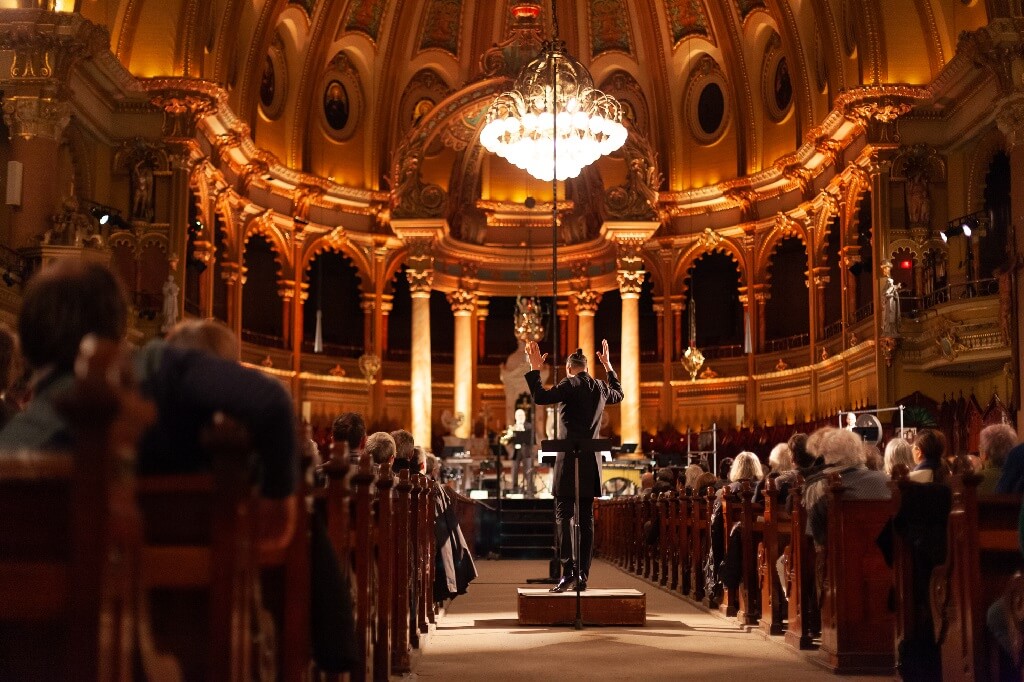
Say this for Walter Boudreau: the longtime artistic director of SMCQ keeps the society true to its modernist principles. The Montréal/Nouvelles Musiques festival opened Thursday in the Église Saint-Jean-Baptiste with a fiercely experimental concert. Crossover sissies need not apply.
“Sound spatialization” was the subtext of the program. The longest and largest work was Michel Gonneville’s 30-minute HoMa, a 2007 evocation of Montreal (the title refers to Hochelaga-Maisonneuve) before, during and after the arrival of Europeans. Scoring was for 24 winds and five percussionists, all of whom were required to migrate to various places in the sanctuary, plus an organist (who of course sat still).
To represent a sermon to the natives by an organ was an interesting idea and the chatter of the winds could be appreciated as commentary and talkback. Wildlife sounds near the end were alluring, as was the flute solo about five minutes after the start. Still, it all came across as a piece of unpredictable starts and stops. The purpose of transporting the gang from place to place (along with Boudreau, in his usual good form as a conductor) was not entirely clear.
Ritual movement was almost the only source of interest in Jean-François Laporte’s Incantation, a work of 2011 for four custom instruments (“trompes-sax”) that looked like lengthy horns of the vuvuzela type outfitted with clarinet (or sax) mouthpieces. They produced either low drones or high harmonics. Since the ambulatory players of the Quasar quartet were not reading from music it is hard to say whether Incantation should be classified as music or an exercise in sonic design. It got a hearty round of applause.
The lone solo work was Ligeti’s Étude No. 1 (Harmonies) for organ with Jean-Willy Kunz (also the organist in HoMa) at the mighty SJB Casavant. In this case the famous instrument was fed air (if I understand the program notes correctly) by an external unit (possibly a vacuum cleaner) in the interest of generating microtonal clusters and creating an “asthmatic” sonority. The piece dating from 1967 was dense, tiresome and (despite the “asthmatic” intentions of the composer) loud enough to bring my fingers to my ears. There were, of course, no harmonies. Ligeti was a master. On a good day.
If all this is starting to sound like a less than perfect night out, there was satisfaction at the beginning from Samy Moussa’s Stasis, a work first performed last year in Munich and here given its North American premiere. Eight horns were arrayed at fixed points; each player was in charge also of one or more gongs.
Brass arranged spatially in a church might suggest Gabrieli but the impetus of Stasis lay more in the Jewish shofar tradition and Tibetan ritual. Surprisingly, the sustained chords created by the ensemble were often triadic and even functional. Moussa understands the tremendous tension that can be generated by withholding the tonic. Also the impact of a well-timed stroke of a gong and the need to shape even simple textures into something like an arc.
The Montreal-born composer stood in the centre of the nave, turning on the spot as necessary and giving Zenlike directions without a baton. If we did not know Moussa to be a conducting student of Pierre Boulez, we might have guessed. He seems to have settled in Germany. Too bad for us.
Playing standards by the SMCQ musicians were stellar throughout. Once a crumbling edifice, the church is now outfitted with a sophisticated lighting array, which was used to good effect. Interesting that 19th-century place of worship should work so admirably as a setting for contemporary music.
ALSO READ:
- SCRUTINY | Azrieli gala a popular success - 22 octobre 2022
- COMMENTARY | Why Playing Political Hot Potato With Artists Is A Terrible Idea - 23 mars 2022
- REVIEW |Tenor Spyres flies high at Lanaudière despite the downpour - 14 juillet 2019



